
St. Mark's Pastors
- Henry Ziegler
- Joseph Welker
- Joseph Frederick Fahs
- Ferdinand C.H. Lampe
- Abraham Reeser Horne
- William Rickert
- Adolphus Leroy Yount
- George G. Kunkle
- William F. Rick
- Edwin Lunn Miller
- Stephen M. Paulson
- Henry Douglas Spaeth
- Paul L. Yount
- J. Ray Houser
- Robert Neumeyer
- Franklyn S. Lambert
- Frederick G. Hasskarl
- Paul F. Bosch
- William E. Hershey
- Robert Ardell Miller
- Jesse Houck
- Dale E. Johnson
- Stephen F. Yelovich
- Walter L. Brandau
- Kenneth R. Elkin
- James E. West
- Brian D. Vasey
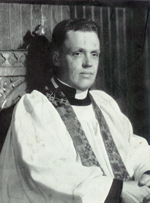 On July 1, 1928 the reins of the parish were taken over by the Rev.
Dr. J. Ray Houser. He was the 14th pastor of the church. With his
spirited and gifted leadership, the congregation grew by leaps
and bounds.
On July 1, 1928 the reins of the parish were taken over by the Rev.
Dr. J. Ray Houser. He was the 14th pastor of the church. With his
spirited and gifted leadership, the congregation grew by leaps
and bounds.
Pastor Houser was born in Westmoreland County, was graduated from Gettysburg College in 1921 and from the Lutheran Theological Seminary at Philadelphia in 1924. From 1924 to 1926 he was a Teaching Fellow at the Seminary. He attended the University of Pennsylvania, receiving an MA. degree in 1927. In 1948 Muhlenberg College bestowed upon him the D.D. degree.
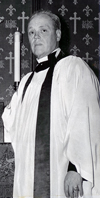 Shortly
after his arrival at St. Mark’s, he organized an elaborate youth and
religious education program. With the increased activities, a
deaconess was called, Sister Mildred Winter, coming to work with the
parish and youth in October, 1930. The Sunday School grew; Church
membership increased; Daily Vacation Bible School and Week day
Church Schools were instituted; and, with the rapid development of
this program, it became imperative to provide more adequate quarters
for this work.
Shortly
after his arrival at St. Mark’s, he organized an elaborate youth and
religious education program. With the increased activities, a
deaconess was called, Sister Mildred Winter, coming to work with the
parish and youth in October, 1930. The Sunday School grew; Church
membership increased; Daily Vacation Bible School and Week day
Church Schools were instituted; and, with the rapid development of
this program, it became imperative to provide more adequate quarters
for this work.
In 1929, the congregation embarked upon a “Greater St. Mark’s Church Expansion Program” to cover a period of five years, characterized by the gathering of funds by all the organizations and the parish as a whole. But once again the people were confronted with one misfortune after another—the bank crash and depression of 1929, and after that the destructive St. Patrick’s Day Flood of 1936 which filed the church with some 20 feet of water above the cellar level. This dunking necessitated repairs and refurnishings to the extent of some $5,000.00 and a temporary halt to the Expansion program.
St. Mark’s became a pioneer in the area of church music as well as religious education. The Ministry of Music program was begun in September, 1937, when Frederick A. Snell was called from Boyertown, Pennsylvania, to organize a system of choirs in the parish. The first public appearance of these vested choirs was at the 85th anniversary celebration of the church on November 5, 1937.
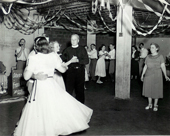 At
the 85th Anniversary Celebration, the pastor proposed the
re-launching of the “Greater St. Mark’s Expansion Program” and the
proposal was enthusiastically received. The membership of the Sunday
School had grown from 224 to nearly 700, with an average attendance
of 450, resulting in crowded conditions and confusion detrimental to
a worshipful atmosphere So a $56,500.00 building program was
instituted to build an extensive addition to the parish house with
classrooms, social rooms and other facilities, and also to replace
the 23 year old pipe organ which had been irreparably damaged during
a severe rainstorm in the summer of 1938.
At
the 85th Anniversary Celebration, the pastor proposed the
re-launching of the “Greater St. Mark’s Expansion Program” and the
proposal was enthusiastically received. The membership of the Sunday
School had grown from 224 to nearly 700, with an average attendance
of 450, resulting in crowded conditions and confusion detrimental to
a worshipful atmosphere So a $56,500.00 building program was
instituted to build an extensive addition to the parish house with
classrooms, social rooms and other facilities, and also to replace
the 23 year old pipe organ which had been irreparably damaged during
a severe rainstorm in the summer of 1938.
Sunday, September 1, 1939, witnessed the dedication of a fine new Moeller organ of 27 ranks of 1,896 pipes and the transformation of the choir chancel at an approximate cost of $11,000.00. This marked the first step in the completion of the Greater St. Mark’s Program.
October 1, 1939 found the congregation engaged in ground breaking ceremonies for the new building. The corner-stone was laid November 26th, and on Sunday morning, June 2, 1940, the new building was dedicated, providing classrooms, church office, a kitchen with adequate facilities and the large spacious “Fellowship Hall.”
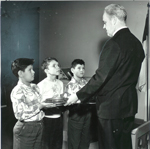 The
spring of 1950 brought a change in the physical appearance of Market
Street and the 98-year-old church. The construction of the Greater
Williamsport Market Street Bridge was started. At first there was
concern that this would cause great problems. But happily, the fears
were unfounded: attendance improved and the spirit of the members was
inspired by the challenging circumstances. August, 1951, saw the
completion of the bridge and the demolition of the old bridge. After the
completion of this project, the congregation endeavored to clean up and
beautify the areas around the church and the interior was redecorated.
The
spring of 1950 brought a change in the physical appearance of Market
Street and the 98-year-old church. The construction of the Greater
Williamsport Market Street Bridge was started. At first there was
concern that this would cause great problems. But happily, the fears
were unfounded: attendance improved and the spirit of the members was
inspired by the challenging circumstances. August, 1951, saw the
completion of the bridge and the demolition of the old bridge. After the
completion of this project, the congregation endeavored to clean up and
beautify the areas around the church and the interior was redecorated.
The centennial of the birth of St. Mark’s was celebrated in 1952. The actual birthday was March 7, 1852 but since this would be the Lenten season, it was decided to observe the event with special services in May. The week of May 4 was full of activity. Former pastors and deaconesses and other dignitaries in the Lutheran Church were present to address the congregation. The centennial pageant, “Ye Shall Be My Witnesses,” was presented at Steven’s Junior High School on May 13 and 14.
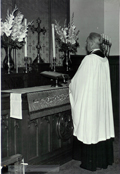 After 25 years as pastor, Doctor Houser announced his resignation to
become president of the Lutheran Seminary at Waterloo, Ontario, Canada
in 1954. On September 14 the choirs and congregation assembled to say
farewell to this pastor who had been responsible for the dynamic growth
of the church.
After 25 years as pastor, Doctor Houser announced his resignation to
become president of the Lutheran Seminary at Waterloo, Ontario, Canada
in 1954. On September 14 the choirs and congregation assembled to say
farewell to this pastor who had been responsible for the dynamic growth
of the church.
In 1967, on the 100th anniversary of the confederation of Canada, the Centennial Medal, in recognition of service to the nation, was conferred upon him by Queen Elizabeth.
He retired as president of Waterloo Lutheran Seminary in 1968. He then served as pastor of St. Michael’s Lutheran Church, Quiggleville, for six years after which the family returned to Canada.
Rev. Houser died on Monday, March 16, 1981.
Read more: